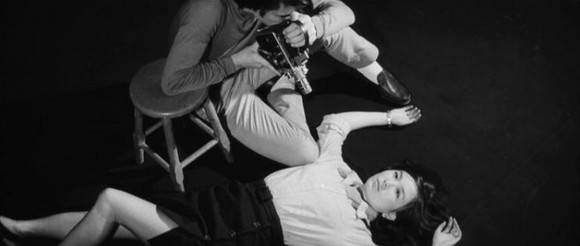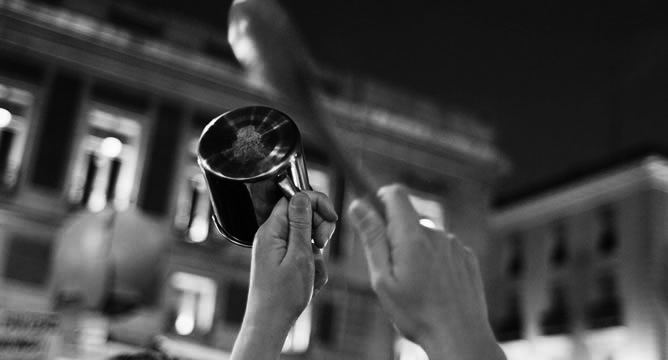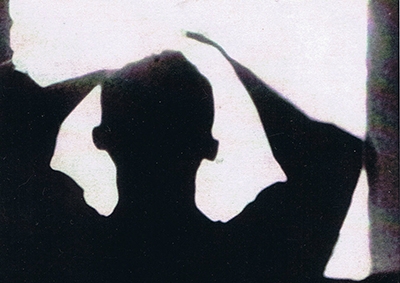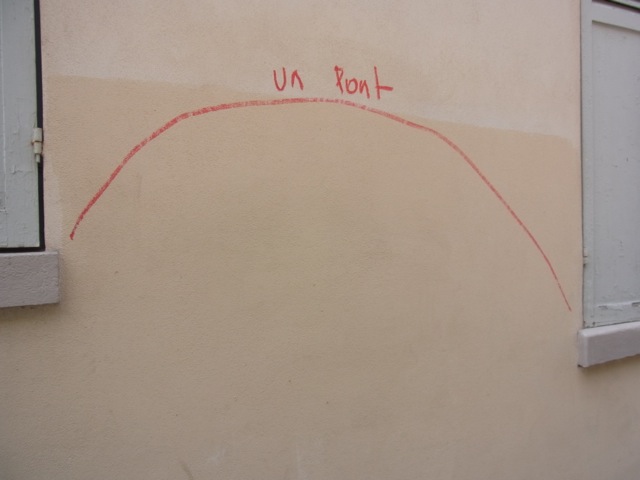
By Pascal Bonitzer and Michel Delahaye
Originally published in Cahiers du Cinéma nr. 224, October 1970. Translated by Felix Gonzalez.
‘Eros + Massacre’ will be screened on 9 October 2014 in KASKcinema, Gent, as part of the ‘Figures of Dissent’ series.
YOSHISHIGE YOSHIDA: After leaving university in 1955, I started immediately at Shochiku as an assistant director. At this time I wasn’t particularly set on making films, but as a literature student, I wasn’t happy with the stuffy academic milieu, and for this reason I left and turned to cinema. When I entered Shochiku, Oshima had already been there a year. For another five years, Oshima, myself, and the rest of the younger generation at the studio wrote scripts, and at the same time – outside the studio, of course – contributed to a journal, “Film Criticism,” of which Oshima was editor-in-chief. At this time Japanese cinema, above all that of the major studios, was a predominantly industrial, commercial cinema, against which we fought violently. By 1960 Japanese cinema was in crisis, mainly due to television. And it was because of this crisis that Shochiku decided to give the younger directors a chance. The first was Oshima, I was next. It was like that, almost by accident, that I was able to make my first feature, which I titled Rokudenashi (Good-for-Nothing, Bons à rien).
When I reflect upon these last ten years, I tend to think in terms of three distinct periods. During the first, I made three features in a row, Rokudenashi, Chi wa kawaiteru (Blood is Dry, Le sang est sec), and Amai yoru no hate (Bitter End of a Sweet Night, Au bout de la nuit douce), all three circa 1960-61. And due to the fact that I had a certain degree of freedom, these three films shared a clearly political aspect. But from that moment, Shochiku began to consider us quite dangerous, and stopped allowing us to make our own projects. Oshima left Shochiku, and I spent a year there without being able to make a film.
Thinking back on it, if I had to define Japanese cinema prior to our generation – in other words, the cinema of Kurosawa and Kinoshita – I would say that these were films of postwar humanism. That is to say, in all of these films, man is obliged to approach another as his “fellow man,” and there was always an infinite faith in “mankind,” which was capable of anything. This was Japanese humanism – meaning that which was imported by the Americans. Meanwhile, around 1950 we had the Korean War, which forced the Japanese to realize that American democracy – or the Japanese democracy imported from America – wasn’t democracy at all. From that moment on, Japanese became aware of the need to think about everything in terms of man in such-and-such a situation. It is in this sense that, from 1955 on, Japanese in general – and we most of all – began to pursue a political stance that was antihumanist.
My “second period” began in the spring of 1962 with my fourth feature, Akitsu onsen (Akitsu Springs, L’Histoire d’Akitsu). This is a love story between a man and a woman taking place over seventeen years following the war. The success of this film allowed me to film Arashi o yobu juhachi-nin (Eighteen who cause a storm, Dix-huit jeunes à l’appel de l’orage), where I showed young workers exploited by society and unable to organize: I wanted to prove that humanism has nothing to do with the plight of the working class. Shochiku withdrew it after four days. In my next film, Nihon dasshutsu (Escape from Japan, Evasion du Japon), the last reel was supposed to show a young man going mad; Shochiku withdrew it from distribution in theaters. I knew at this moment that I could not in any way continue working for Shochiku.
Thus I left there in 1964. Thanks to a collaboration with a newspaper, I was able to make, independently of the five big studios, a film called Mizu de kakareta monogatari (A Story written with Water, L’Histoire écrit sur l’eau). In 1966 I started my own independent production company, Gendai Eiga Sha (Society of Contemporary Cinema). There I made Onna no mizuumi (Woman of the Lake [sic], Le Lac de la femme), Joen (The Affair, La Flamme ardente), Honô to onna (Flame and Women, La Flamme et la femme), Juhyo no yoromeki (Affair in the snow, La Nuit du verglas), and Saraba natsu no hikari (Farewell to the Summer Light, Adieu de la lumière d’été). Despite being independently made, all these films were nonetheless distributed by the five big studios. In comparison to the earlier periods, now I had more freedom in choosing the subject matter for my films. For this reason I was able to hone in on the theme of man’s concrete situation, and specifically, I wanted to interrogate his subconscious. Thus, sex. It was in this way that I made Eros plus Massacre, the first film for which I did not secure a distributor in advance – in fact, I still have not found one in Japan. In exchange, I had the most complete freedom.
CAHIERS: You spoke of the humanism of the post-war period and mentioned Kurosawa. We would love to have your opinion of someone else of the preceding generation, namely Mizoguchi.
YOSHIDA: First of all, Mizoguchi is a filmmaker who made films before the war, during the war, and after the war, whereas Kurosawa began during the war. In fact, Mizoguchi began working in cinema at the very start of the Showa era, that is to say, around 1925, in other words, before the period of Japanese militarism. For this reason, he had the liberty to create a “cinéma d’auteur.” There is a continuity in Mizoguchi’s cinema, which one could summarize with the formula “popular cinema.” But thanks to the very ambiguity of such a formulation, he was able to continue to film freely even after the war.
Kurosawa, on the other hand, made his first feature, Sanshiro Sugata, during the war, at the time when Japanese cinema was in the grip of the militarist state – something that, in my opinion, could have influenced even his postwar films. The great theme of Kurosawa’s films is stoicism, a theme to which he was led by militarism and one that he carried over into his postwar films, something we criticized in them during the fifties.
Let me clarify: during the war, the Japanese lived within a system shaped like a pyramid, in which everyone suffered the same fate. At the top of this pyramid was the Emperor, then the state, the family, and finally death – this was for all Japanese. In Kurosawa’s films there is always, as you well know, the conflict between good and evil, inherited from Dostoievsky, for whom he had a great admiration. And if he did nothing but repeat this theme in all his films, it was because in them existed only a space that was closed, and lacking the dimension of time – there was no future, nothing to look forward to. This was the limitation of postwar humanism.
CAHIERS: What sort of time exists in Eros plus Massacre?
YOSHIDA: One could say that in this film there are two times, chronologically speaking: ours and that of fifty years ago – Osugi’s time. In this sense one could say that it deals with the problem of time; but for me what’s important is the present. Reflecting on the present is also reflecting on the future: it is at the same time wanting to change the present and seizing a hold of that which will become the future. This is the subject of the film, and not Osugi as a historical character per se. The fundamental theme is: how to change the world, and what is it that needs to be changed? Reflecting on the present situation through the medium of an era already past, I came to believe that Osugi’s problems continue to be ours.
Osugi is very well known in Japan – one could say almost legendary: he is someone who spoke of free love. He was assassinated in 1923 by an official of the state, massacred by the power of the state. This is what all Japanese historians believe; but this historical estimation only enlightens the past, and not the future. In making this film, I wanted to transform the legend of Osugi by means of the imaginary. Sure enough, Osugi was oppressed by the power of the state in his political activities. But most of all, he spoke of free love, which has the power to destroy the monogamous structure, then the family, and finally the state. And it was this very escalation that the state could not allow. It was because of this crime of the imaginary (or “imaginary crime”) that the state massacred Osugi. Osugi was someone who envisioned a future.
CAHIERS: It seems that the imaginary gives the real time of the film: not either of the times that you spoke of, but a third time, namely, the dialogue between the past, the present, and the future.
YOSHIDA: Regarding this subject, I would like to remind you of the murder attempt in the second part of the film – the knife penetrating Osugi’s neck, filmed in a realistic manner: this is the plain and simple representation of the narrative. In filming this attempt a second time, my intention was to destroy this narrative, to deform the actual event, in order to enter into Osugi: I thought that maybe Osugi preferred to be killed –in contrast to what the first version of the attempt showed. It comes right after he starts to consider the destruction of the revolution he desired; it was after this destruction that he began to speak of free love, in other words, of an imaginary crime. In this version of the attempt, then, it should not come about because of jealousy, not due to a psychological element, but from a political cause. Thus I had Osugi say: “Revolution is only the renunciation of the self,” or “in love and terror, there is ecstasy.”
In having Osugi say this, I wanted the spectator to feel the absence of revolution in the present situation. For the third version of the attempt, I tried to show the contrary view, namely Noe, the attacker. In opposition to Kurosawa, it is always the renunciation of the self that is important for me: it is only this way that communication with Noe and Itsuko is possible, and only by means of it that one is able to think the future.
CAHIERS: How do you situate your film in relation to the hero, who is an anarchist, and in relation to anarchism in general?
YOSHIDA: Osugi’s era is that of the Russian revolution, and thus communism was not yet well established internationally. I’m not completely in agreement with the internationalist bent of communism. One of the characters in the film visited Russia in 1923, and the political situation in Japan was at that time unsettled: social revolution had not yet taken on any shape. It was because of the ambiguity of this period that I became so interested by Osugi’s anarchism.
The Japan of today, everyone knows its situation: there are conservatives and on the other side communists, with the socialists in between; this society is undergoing a period of stabilization, but this is being contested by anarchist students, the Zengakuren. It is for this reason that I chose to deal with Osugi’s era, one where society had not yet become stable.
CAHIERS: As for the problem of free love, what correspondence does the film establish between, on the one hand, the Osugi – Noe and Osugi – Itsuko relationships, and on the other, those of contemporary couples?
YOSHIDA: First of all, when it comes to the Osugi – Itsuko relationship, it was what one could consider the freest imaginable, given the social conditions. Osugi never thinks of the possession of wealth – only of its distribution; and in the film, he imposes on Itsuko his “three conditions”: live separately, and maintain economic independence and sexual liberty between them. This is a triple negation: of monogamy, of the economic system, and of the sexual structure as well. The result is the scene in the teahouse: Itsuko’s attempt. Nevertheless I have a lot of sympathy for the life of Osugi and Itsuko, for their “social wound.”
As for Osugi and Noe, it was in order to deal with their relationship that I introduced the imaginary. The principle is the same as for the third attempt: a perpetual effort to go beyond the other, in order to arrive at a true freedom; as in the third attempt, here is expressed that eternal movement, the intent to exceed each other.
As for contemporary couples, I have already shown free love as a form that exists in the present. In setting up a parallel with Osugi, I suggest that free love will certainly come to act against the social structure. Thus: from love to politics. It is obviously this which the title signifies: that if a way of thinking like Osugi’s exists within free love, massacre will follow. Free love is an eternal movement that seeks out total freedom. What I take to be the most important is Osugi’s dynamism, which is evident during the third attempt – in other words, the dynamic of the negation of the self, and thus one which is directed toward the future.
CAHIERS: I would like to ask a more specific question: the contemporary couple which does not succeed at lovemaking, should it place itself in very specific conditions, create a certain type of relationship, in order to get there? I can’t help but think of a situation very similar to that in Oshima’s Diary of a Shinjuku Thief, where it is blood that plays the role that fire has in your film.
YOSHIDA: I don’t know what Oshima would say, but as for me, I believe that these two elements have the following meaning: living in Japan, this is already absurd, and fire and blood are reflections of this absurdity, in as much as they are “abnormal” elements. In this absurd situation, one is obliged to change, and one must grasp this transformation; in grasping it, one will be able to understand the social situation itself. Let me explain by going back to the great “humanist” filmmakers: they always took man to be “authentic” regardless of his situation, of his predicament. We, on the contrary, believe that even if man is not “authentic,” it is necessary to reflect upon him, and in this way to arrive at his condition.
CAHIERS: It would seem as if young Japanese filmmakers all deal with the same theme: Eros and Politics. Do you think that this is a general trait of the new Japanese cinema?
YOSHIDA: I don’t believe that one can speak of a “school” or of a “group” of filmmakers; I don’t think that here you can find the link among the young Japanese directors. But maybe this is the way it appears from your perspective in France. In Japan politics has not yet become scientific: it is still too impregnated by humanism. For this reason, it is quite easy for a Japanese to deal with sex within politics, or vice versa: what matters to us is the dynamic aspect of this relationship. That is, it is important for us that one should be able to grasp politics in its raw state, rather than as a science. I think one can find similar tendencies in Brazilian cinema, or in Buñuel, where politics is no longer dealt with in a scientific fashion. [This contrast is elucidated further at the very end of the interview – Trans.]
There is another factor, which is the hold that the big five studios continue to exert over Japanese cinema. They are in transition, due to the aforementioned crisis; but the films they produce continue to be dominated by a “Japanese ethos.” Of course, as independent filmmakers we make films against this moral code; and for this, the most effective themes are sex and politics.
I’d like to add one very important thing: in regards to the very first wave of independent productions, right after the war, they tended to reflect the politics of the Communist Party – in other words, these were purely ideological films. Thus one had not yet dealt with politics in the sense in which we intend.
CAHIERS: And Mizoguchi’s films, don’t you think that they deal directly with politics?
YOSHIDA: Mizoguchi is considered as a “réaliste à la japonaise,” a realist who depicts things such as they are. This is of course a very vague definition, which I will try to make clear by means of an example: if one wants to speak of the past, one cannot help but interpret it from the point of view of the present. The directors of Mizoguchi’s and Kurosawa’s generation were always at risk of falling into the trap of humanism, a trap Mizoguchi knew well. For example, he deals often, in his films, with prostitutes. For us, we considered them to be “alienated” by society, but Mizoguchi preferred at the same time to talk of the pleasure that such a woman might experience, and in this he came to the very brink of the problem. The best of Mizoguchi’s works from this perspective is The Sisters of the Gion (the 1936 version) – this is an absolutely anti-humanist film.
CAHIERS: But for example, in The 47 Ronin, doesn’t Mizoguchi reject the specific political meaning that would have been attached to the story at this time [i.e. this film was made during the war – Trans.], in order to give it a completely different one?
YOSHIDA: It’s a long time since I saw this film, and I only have a vague memory of it. Nevertheless, I think that your point is well taken: Mizoguchi is a filmmaker who appears to have turned his back on political issues, whereas in reality he wanted to go beyond them. According to him, politics is only one of the elements that make up a particular period, and what he sought was to get to the very bottom of the situation. But our situation is more complex than that of his time; even if one wanted to take the same attitude, it wouldn’t be possible to get to the bottom of things. In his time there was a very clear distinction between oppressor and oppressed, between power and the people. Thus, Mizoguchi’s mode of realism was completely effective. He was perfect, but this wouldn’t be the case for our time.
CAHIERS: And Mizoguchi’s final films, such as New Tales of the Taira Clan – don’t you think that they are more expressly, more openly political?
YOSHIDA: When it comes to this film, as with many others by Mizoguchi, the reaction of Japanese and French viewers has been different: perhaps your judgment is better due to your greater cultural distance. Nevertheless, I find that – in contrast to Ugetsu and Street of Shame, which are quite beautiful – Mizoguchi’s two color films (The Empress Yang-Kwei-Fei and New Tales of the Taira Clan) are “costume-plays.” It seemed to me that in those films Mizoguchi lost his dynamism, his “transparent” realism. (He found his energy again, however, with Street of Shame.) Maybe the evolution of his films corresponded to the evolution of the situation in Japan.
I’d like to add something here, in order to draw sharper distinctions among the three best-known filmmakers of the older generation, Mizoguchi, Ozu, and Kurosawa. Specifically, in order to try to define their various successes as “realists.” Ozu, from the start, dealt in his films with the condition of the Japanese family, of the Japanese citizen. Right after the war, the family-system was in crisis. Japanese had a profound attachment to the family, and Ozu’s films, which depicted a vanishing family life, were very effective, they were profoundly realist. But once peace was established, he felt obliged to deal with young people who leave their families, and all of these young characters were very banal: this is how he lost his realism. I’ve already spoken of Kurosawa, of his stoicism. His realism could easily accommodate itself with the intentions of the Japanese establishment and power structure [du Pouvoir au Japon]; the stoic man is precisely what this power establishment was seeking. In this sense, his films are quite dangerous.
As for Mizoguchi, his starting point was always “pathos” – an abstract emotion – in order to arrive at the perfection of his realism. Mizoguchi’s realism is perhaps the one that might outlast the other two. It appears not to have any interest in the current social situation, and instead concerns itself stubbornly with individual passions. But behind this appearance, one might be able to detect a political critique of society.
CAHIERS: How many new independent production companies exist? And who makes films for them?
YOSHIDA: It’s quite difficult to answer. There are two main tendencies in independent Japanese cinema. There are some, such as Imamura, Oshima, and I, who came out of the big five studios. These are people who have lived the history of Japanese cinema, so to speak, and who only now have figured out what sorts of films are necessary – it is only now that we have begun making the films that we need to make. Then there are other independent filmmakers who have never had any type of relationship with the big five: they are making films based on their own cultural situation. I can’t characterize these filmmakers for you, since they have quite different backgrounds: they came out of documentary production, television, advertising, or militant cinema. Among them one could mention Teshigahara, who started in documentaries, as did Hani or Shinsuke Ogawa, who came out of the student movement.
One should also make note of those filmmakers involved in what one might call “eroduction.” While the big five studios have almost a complete monopoly in distribution, there are several theaters which program independent films such as those of Oshima, Imamura, or myself, and a few others which specialize in erotic films. One might perhaps find a similar situation in France. Among the filmmakers who produce such “erotic” films, some are quite interesting. They are conditioned by demand and other commercial considerations, to be sure, but a few are able to take advantage of these restrictions to make the sort of films that they want. It’s a little like homeopathy; sometimes the cure is worse than the affliction. Two I could mention are Koji Wakamatsu (whose Six Wives of Ch’ing you’ve seen here) and Masao Adachi.
CAHIERS: You’ve mentioned a few names we know more or less well, but you haven’t said anything of Masumura: where would you place him?
YOSHIDA: I was quite in accord with Masumura. When we began to work for the big five studios, that wasn’t the revolution; rather, during the two decades that followed the war, a revolution had taken place within those companies. Masumura was the most distinguished of our group, when around 1960 we formed what is now called the “Japanese new wave.” As you know, he studied in Rome and started out at Daiei, at first as assistant to Mizoguchi, among others, and later as director. Perhaps it was due to Mizoguchi’s influence that Masumura was able to transplant an abstract, European pathos to a Japanese context. The genre-type films he made for the big studios demonstrated his abstract and quite flexible touch. These films astonished us: it delighted me to see how he managed to find an angle, a way to shoot such things within the domain of the big studios. He was the first one to prove to us that the system wasn’t all-powerful, and that one could successfully go against it.
At the present time, Masumura’s position inside Daiei is quite isolated. It isn’t a healthy situation in which to make films; it is quite abnormal and perhaps this is why his films have taken on an extremely sadistic or masochistic aspect. A filmmaker close to Masumura is [Kô] Nakahira, director of Crazed Fruit. In the critical journal we edited with Oshima, we called them “modernists”: people who wanted to reform things. But as the reforms that they sought have not taken place, they have resorted to shooting very dull subjects, where all that remains is technique.
CAHIERS: Why do you love Brazilian films, and those of Buñuel?
YOSHIDA: I didn’t exactly use the word “love.” I only mentioned them in order to explain the difference between Japanese and “European” cinema. When Japanese experience something irrational or absurd, they tend to accept it, whereas the “European” method is to try to analyze it and ultimately arrive at an explanation. Japanese start out by accepting, by swallowing, whatever leads to a certain result, and they then try to get beyond it. (Les Japonais commencent à avaler, à accepter, ce qui donne un certain résultat, et ils essaient de dépasser ce résultat.)
Obviously I’ve put this in a very vague and impressionistic way, but I believe that the fundamental difference between Japan and the West is there. For example, when it comes to the relationship between sex and death, in Oshima’s films as well as mine, one often mentions the name of Georges Bataille, but this is only an approximation…




